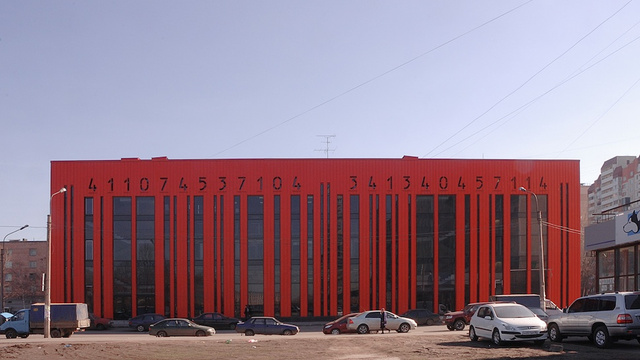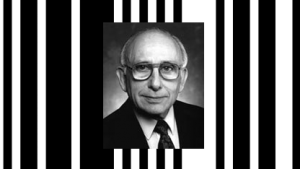Barcode Architecture
 Though they may not take center stage most of the time, barcodes are a part of everyday life even if we don’t realize it. From every product you buy or use to tracking patients at a hospital, barcodes have become deeply integrated into modern life. It’s no surprise then that such a culturally embedded technology would effect other realms like architecture and design.
Though they may not take center stage most of the time, barcodes are a part of everyday life even if we don’t realize it. From every product you buy or use to tracking patients at a hospital, barcodes have become deeply integrated into modern life. It’s no surprise then that such a culturally embedded technology would effect other realms like architecture and design.
These are some of the more interesting examples of buildings that take their design inspiration from the humble little barcode.
GS1 US Celebrates 40 Years of the Barcode
 This year marks the 40th anniversary that organizations united to adopt a universal way to conduct business using GS1 Standards. Beginning with a UPC (Universal Product Code) barcode, the GS1 System of Standards has set the foundation for a technological revolution that has changed the way companies, from manufacturers to retailers, conduct business around the world. Now, more than five billion GS1 barcodes are scanned every day.
This year marks the 40th anniversary that organizations united to adopt a universal way to conduct business using GS1 Standards. Beginning with a UPC (Universal Product Code) barcode, the GS1 System of Standards has set the foundation for a technological revolution that has changed the way companies, from manufacturers to retailers, conduct business around the world. Now, more than five billion GS1 barcodes are scanned every day.
In the 40 years since their adoption, GS1 Standards have grown into a global system, used by more than two million companies doing business in 150 countries across 25 industries, including apparel and general merchandise, fresh foods, consumer packaged goods, grocery, foodservice, healthcare, and defense
Introduced to speed the supermarket checkout process, the grocery retail industry was the first champion of standards in 1973. Today, supply chains representing nearly every sector in the world rely on GS1 Standards for identifying, capturing, and sharing information about goods, services, locations, and more in real-time. Barcodes and Electronic Product Code (EPC) enabled radio frequency identification (RFID) have evolved to capture a broad range of information to drive supply chain visibility.
Barcode and POS News Resources
 The worlds of Barcoding and Point of Sale are constantly evolving and changing to the needs of many types of businesses. Advances in technology and the need for mobility, constantly drive changes and advancements.
The worlds of Barcoding and Point of Sale are constantly evolving and changing to the needs of many types of businesses. Advances in technology and the need for mobility, constantly drive changes and advancements.
Keeping up with all the product updates, new solutions, and current innovations is no easy task. Luckily, there are a host of online resources from industry leaders and independent users we can put to use. In addition to this site, these other resources are ideal for finding out about new scanners, mobile computers, and POS systems as well as different ways to implement them in your business.
Co-Creator Of The Barcode Dies
 The co-inventor of one of the most indispensable technologies of the 20th century that labels every retail product, the barcode, has died. The death of Norman Joseph Woodland, who was 91, was confirmed by his daughter, Susan Woodland. She said he died on Sunday in Edgewater, New Jersey, from the effects of Alzheimer’s disease and complications of advanced age.
The co-inventor of one of the most indispensable technologies of the 20th century that labels every retail product, the barcode, has died. The death of Norman Joseph Woodland, who was 91, was confirmed by his daughter, Susan Woodland. She said he died on Sunday in Edgewater, New Jersey, from the effects of Alzheimer’s disease and complications of advanced age.
Mr Woodland and Robert Silver were students at Philadelphia’s Drexel University when Mr Silver overheard a grocery store executive asking an administrator to support research on how product information could be captured at checkouts. The pair earned a patent in 1951 with Mr Woodland’s idea to create a shape of concentric circles. The technology did not catch on until the 1970s, when Mr Woodland’s employer IBM promoted a rectangular barcode that was adopted as the standard.
The barcode may have come from a humble beginning but has become the de facto means of tracking any kind of product or process today. Woodland’s innovation and contribution to the technology was crucial to improving businesses around the globe.
Happy Birthday! The Barcode Turns 60!
 Now a common place tool used at almost all levels of business, the barcode is now celebrating 60 years of use!
Now a common place tool used at almost all levels of business, the barcode is now celebrating 60 years of use!
The now-ubiquitous patch was first patented in 1952. The first design, invented by Norman Joseph Woodland and Bernard Silver, resembled a circular bullseye. Originally created to help speed up the check out lines at a grocery store, they are now use to track almost anything. Asset management, inventory, POS, and ID issuance are just some examples of processes that would be much more difficult with out the help of barcodes.
Today, 60 years after the barcode was first patented, there are more than 5 million individual barcodes in use around the world. Oddly enough, one of the first retail products to use a barcode was Wrigley’g gum! Through the years, many different types of codes have been developed, but none as popular and well-known as the UPC barcode, used on retail items, and the quickly advancing QR code you can scan with your smartphone.
Wherever you look you can find the barcode hard at work. With advancements in scanner technology and more flexible barcode development, we’ll hopefully see another 60 years of barcodes!
IUID Item Unique Identification
In October 2008, the US Department of Defense published version 2 of the UID (Unique Identification) guidelines requiring a broad range of assets to be marked with a 2 dimensional data matrix code that is unique at the item level. Implementation is increasing, covering both new items and assets already in service. With an extreme assortment of surfaces and durability requirements, finding a product to reliably track these items can pose a significant challenge. Intermec’s comprehensive UID media offering simplifies this daunting task with proven labeling solutions.
Mission-critical tracking has been at the core of Intermec’s business throughout its history. Intermec media offers a number of products available off-the-shelf to meet UID requirements, and offer custom materials and configurations to meet particularly stringent requirements. Using these proven products and printing technology to satisfy UID requirements limits exposure and minimizes cost of complying with this mandate.
35 Years On: Universal Product Code lives up to name

From its beginnings as a service to help supermarkets speed up the checkout process, the Universal Product Code, known as the bar code, celebrated its 35th birthday Wednesday June 3rd as a technology that has expanded to applications far and wide.
One of the world’s best-known symbols, the UPC comprises a row of 59 machine-readable black-and-white bars and 12 human-readable digits. Both the bars and the digits convey the same information: the identity of a specific product and its manufacturer.
First developed to help grocery clerks quickly total customers’ bills, the first live use of a bar code took place in a Marsh Supermarkets store in Troy, Ohio, on June 26, 1974, when a cashier scanned a pack of Wrigley’s gum, according to information from GS1 US, a Lawrenceville, N.J., nonprofit that says it is the developer and administrator of the UPC for more than 200,000 businesses in the U.S.




